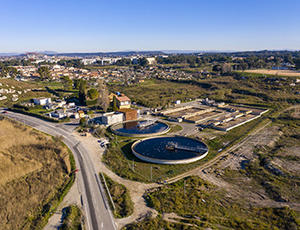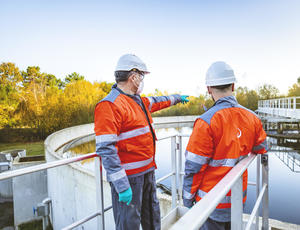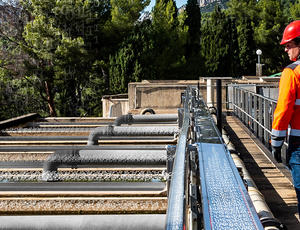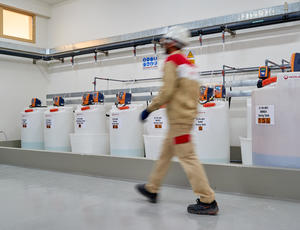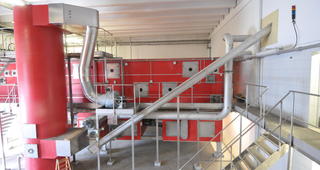Anita™ Mox is a cost-effective and sustainable deammonification solution for the treatment of streams highly loaded in ammonia.
Overview
High ammonia concentration with low chemical oxygen demand (COD) concentration are typical characteristics of the rejected water coming from dewatering of the digested sludge. Usually sent back to the main wastewater flow, the treatment of this ammonia load through conventional nitrification/denitrification can be quite cost-intensive or in some cases jeopardize downstream sludge digestion processes intended for sludge reduction or enhanced biogas production.
To address these issues, Veolia Water Technologies subsidiary AnoxKaldnes has developed Anita™ Mox, an alternative solution to conventional nitrification/denitrification processes that limits the impact of digestion on the main wastewater treatment plant line. Anita Mox is another application of the well proven Moving Bed Biofilm Reactor (MBBR) technology. Using a single-stage MBBR with a proven aeration control strategy, Anita Mox not only dramatically (>85-90%) reduces ammonia, but also removes nitrogen by 75 to 85% on the main treatment line, making it an ideal solution to upgrade an overloaded existing wastewater treatment plant, at a competitive cost.
How Anita™ Mox works
An anammox process takes place in two steps: aerobic nitritation by ammonia oxidizing bacteria and anoxic ammonia oxidation performed by anammox bacteria. In Anita Mox, the two steps take place simultaneously in a single reactor.
The aerobic and anoxic reactions both occur in a single MBBR reactor equipped with plastic carriers specially designed to support the biofilm. In the reactor, specific conditions are maintained in terms of pH, temperature and oxygen level for the ammonia-removing bacteria to provide the optimal environment to develop as a biofilm on the carriers, thereby preventing washout of the bacteria from the reactor.

A key element of the Anita Mox process is the incorporated cloud based holistic service that allows for real-time optimization of process performance.
Based on operational data from online sensors and algorithms, this digital solution calculates optimized setpoints for equipment, to adjust parameters, providing a state-of-the-art auto-pilot to optimize the whole treatment process.
Hubgrade and its Services allow clients benefits from start-up all the way through continuous operation allowing them to optimize environmental, operational and financial performances.
Features and benefits

Compact, robust and flexible process

Best in-class security against anammox bacteria loss

No carbon source needed

Reduce sludge production

Almost 60% oxygen savings

Reduce electric power consumption by 60%

Lower CO2 emission
Applications
Services
Resources & Product range
Contact
Today we expect wastewater treatment plants to do more than just treating wastewater. Besides that, we want it to be energy-positive, resource recovery centered and with this minimal carbon footprint. Veolia’s ANITATMMox deammonification solution for cost & energy-efficient Nitrogen removal from municipal and industrial effluents checks all the boxes. ANITATMMox is the key component of efficient and sustainable wastewater treatment plants of the future.

Luca Quadri
Deputy Sales Director
Contact Luca through his LinkedIn account
FAQ about Anita™ Mox
Why is removing ammonia from wastewaters important?
Ammonia (NH3) is a colorless chemical compound, based on hydrogen and nitrogen, emitted from animal manure and nitrogen fertilizers used for crop fertilization. Ammonia monitoring is crucial in wastewater treatment plants as it can reach high levels in water due to bacterial action. Excessive accumulation of ammonium in discharged water can result in significant ecological problems such as increased eutrophication of lakes and rivers, excessive algal growth and a reduction in dissolved oxygen, causing toxicity to fish, other aquatic creatures, and wildlife.
What makes anammox bacteria unique?
Anammox bacteria have a unique metabolic pathway that allows them to utilize ammonia and convert it directly to nitrogen gas. This is unlike traditional nitrification-denitrification processes that require large input of energy and external carbon dosing. Anammox processes involve two steps. The first step is nitritation where ammonia oxidizing bacteria convert a portion of the ammonia to nitrite. This involves a small input of oxygen to the system. The anammox bacteria then use the produced nitrite and the remaining ammonia in their metabolism with the end result being nitrogen gas. No additional oxygen or carbon source is needed.
How long does it take to start-up an Anita™ Mox process?
It is best to consider a 4-6 months time frame for a new ANITA Mox solution to reach full capacity. AnoxKaldnes and Veolia provide a portion of seeded anammox carriers, as part of their offer, to enhance the start-up. A number of factors can influence the start-up time but the use of Hubgrade will reduce time, risk and cost.



